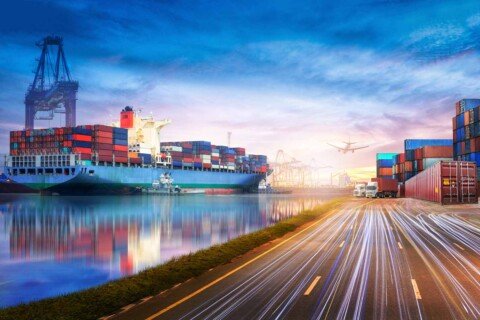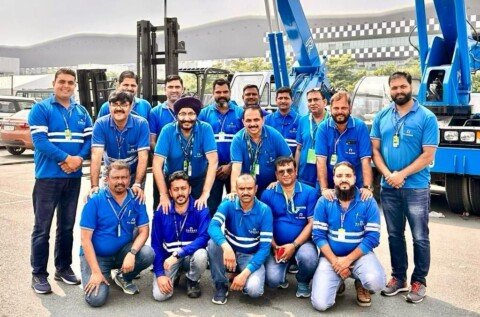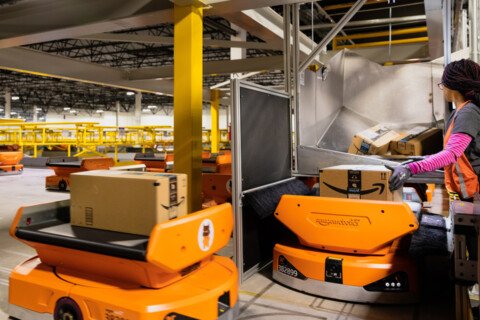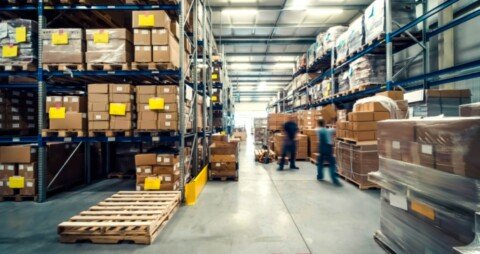As we step into 2021, the logistics industry is slowly expected to return to its full pre-COVID levels. The trucking and warehousing sector is also anticipated to gradually go bacl to normal over the course of the new year. But, with the shock and awe and potential learnings behind, logistics players are trying to figure out new ways to build on capabilities and accelerate activity as they make the move from here. Additionally, last-mile and hyper local deliveries will continue to grow at a rapid pace as e-retail continues to thrive. Storage and fulfilment opportunities will also increase as companies tend to get closer to customers.
Upamanyu Borah
India’s logistics sector was booming even before the turbulent events of this year. COVID-19 and the consequent impact on internet sales have served to fuel the sector’s growth. Face-to-face interactions were limited, and businesses were forced to embrace technology to move online.
Despite the conditions in 2020, areas such as food and grocery delivery were mushrooming. We saw micro fulfilment making inroads, driven by the e-retail boom and escalating demand for last-mile delivery service. All these things will continue to increase in 2021. COVID has just paved the way for growth.
Logistics businesses are rethinking their approach to systems and processes and technology adoption, not only to effectively navigate unimagined scenarios but also smarter ways of operating in the ‘new normal’. For instance, organisations will adopt solutions that cover various aspects of ‘flexi-work’ environment with the help of platforms to manage and secure remote engagement and also support communications and collaboration.
However, during the pandemic, businesses saw how stretched supply chains pose several disadvantages and could break at any point. When this happens, it disrupts the delivery of goods, creating a domino effect. Businesses are hurt, and consumers are forced to either wait or be resource less.
To prevent this problem in the new normal, manufacturing companies have to reduce dependency on a single source of supply. Companies should look sourcing raw materials and supply ingredients from multiple manufacturers that offer the same quality. A ‘vocal for local’ movement has now become a necessity for both business and human survival. At the same time, companies should consider investing in resources that shortens the supply chain, helping deliver shipments at the soonest possible time.
No doubt, the future of supply chain and logistics will be defined by seamless digital connections between human to human (procurement to distribution) and internet-enabled devices (yard management to real-time visibility).
More storage sheds in prime locations
Traditional locations for logistics centres (i.e. tier I cities and on urban boundaries) are no longer enough to cover demands for last-mile deliveries and reverse logistics. More warehouses will be needed close to tier II and III towns. As a result, we may see increased mixed-use solutions, including in some instances residential combined with urban logistics.
Additionally, e-commerce has been the major driver of innovation in warehousing and the idea of setting up warehouses in the middle of a city will fulfil the requirement of being able to be as close to the customer as possible.
E-commerce firms are ramping up warehousing and logistical operations with a sharp focus on smaller cities and towns, expecting an uptick in sales in the coming festive season amid a pandemic cloud.
A quicker rebound in online sales after the lockdown, along with higher demand from buyers and on-boarding of more sellers in tier II and III towns, is prompting e-commerce companies to take up larger warehouses in a multi-city expansion strategy.
“Owing to robust demand of e-commerce and other consumer-led goods in smaller cities, the warehousing segment is likely to bounce back quicker than other segments, as developers are keen on setting up fulfilment centres and Grade A warehouses to help absorb the demand,” says Abhijit Malkani, Co-CEO and Country Head, ESR India.
“We anticipate a rising demand in speculative buildings in the coming months due to the delay caused by the pandemic. We foresee multi-level warehousing to gain prominence.”
“The pandemic has led to a surge in grocery commerce and delivery of essentials. Time is of the essence in such formats; hence in-city distribution is the need of the hour.”
“Companies want to adopt automation to further increase their efficiency, consolidate their businesses, and enhance safety initiatives and contactless business processes, and Grade A spaces are more adaptive for such implementations. Modern tech-powered warehouses will rule the roost, pushing inferior grade properties down the demand pyramid. These spaces will remain in demand in key tier I and II cities,” Malkani continues.
Infusion of analytics and intelligence to connect people to parcels
As consumer behaviour changes post COVID-19 and amid uncertainty, major industry players will change services and offerings. This will require transporters or trucking industry players to support their customers with new offerings and delivery models. For instance, focus on handling capacity by resource maximisation, reducing cost by improving assets utilisation, and improving efficiency by route optimisation.
The need is to reposition their operational framework to enhance visibility, enable digital operations, and ensure safe logistics operations to cope with the changes in the new normal.
IoT-driven location tracking technology is transforming the transportation industry, giving logistics companies greater ability to manage their fleets and improve efficiencies. It is not surprising to know that the adoption of IoT technologies in the logistics industry will continue to grow with a CAGR of 13.6 percent through 2024.
Using analytics and data-driven machine learning, route optimisation identifies the most efficient delivery route possible based on variables such as traffic congestion, distance, turns and intersections. These in turn would enable logistics companies to reduce vehicle maintenance and fuel costs, save time and improve customer satisfaction.
Also, smart dispatching which is enabled by fastening IoT sensors to trucks helps to collect wealth of valuable data about a fleet, and using smart tags to create a coordinated communication system between shipments, vehicles and dispatchers. This enables logistics companies to track driver performance and generate reports, assess areas for improvement, and respond to emergencies faster.
“The growing adoption of cloud-based software, innovations as a result of more connected technologies that use application programming interface (API) to integrate into transportation management system (TMS) and the ongoing push to improve information sharing and transparency across all levels of logistics operations will further drive customer service levels,” says Uday R Sharma, COO, Spoton Logistics.
“Modern day shippers look for constant supply of reliable carriers real-time insights. They also want extensive visibility into the consignment’s journey at the piece level.”
“For instance, we have developed an in-house AI model called ‘Reinforced Learning’ to drive network efficiency. The AI engine, using live and legacy operation details related to the customer, enables quicker deliveries, allows efficient fleet utilisation and faster reaction to operational issues and dynamic customer requests, more effectively. Besides increasing the efficiency of Spoton’s pan-India network, this AI engine is also helping improve overall kilometers travelled by our trucks,” says Sharma.
“Whether it’s in the logistics, e-commerce retail or any other industry, using data is not a choice anymore. The kind of complexities that exist and the very thin margins of error, data is the only way out to plan things well,” says Aditya Shah, Executive Director, V-Trans (India).
“Predictive analytics gives you more confidence on your business strategy. You can check multiple times in your train and test data at what confidence level and accuracy you want to move ahead. Specifically, in e-commerce logistics, there are many areas where data helps, be it inventory routing, location optimisation, demand and delivery forecasting, predictive modelling, and more.”
In the last couple of years, Shah says, “We have built our decisions completely on data-backed predictive models with accuracy of 95% and above. This has really helped us in many areas of network expansion, business development, enhancing service levels, ultimately impacting the bottom line positively.”
The automated warehouse force
The new normal will require operations to be adjusted and regulated at distribution centres and hubs to minimise physical contacts, handle labour shortages and improve efficiencies to make products available at the right place at the right time.
Implementing goods-to-person concept or robotics-based picking will help in near touchless operations to handle inventory, as well as plays a key role in warehouse management through the prediction of rotation of supplies. Rise in e-tailing will require switch in processes at warehouses to enhance order fulfilment capabilities for each picking, as we enter tomorrow.
At present, logistics companies seek to be more ‘elastic’ to cope with demand spikes or falls caused by high-profile events or seasonal variations. Companies are looking to employ robots in any way they can throughout their operations—from manufacturing to warehousing and distribution, where they perform picking, packing, put-away, and truck-loading tasks. The objective is to bring the handling costs down by maximising the throughput. Innovative automation must be used to meet the objective of serving customers quickly as required, and at the same time, keep the costs under control.
“Hygiene standard improvements are imperative. With physical distancing norms in place and when industry was facing a labour crunch due to migration, dependence on automation has definitely helped,” says Jasjit Sethi, CEO, TCI Supply Chain Solutions.
“I certainly believe that automation now will be a business continuity consideration along with commercial consideration to accommodate for operating during unprecedented circumstances like today. To avoid any possible spread, the inkling is towards reducing the number of touch points in handling of cargo, thus automation becomes crucial here.”
“With above, palletisation of cargo throughout the supply chain will improve to facilitate automated handling that shall ultimately contribute to lower handling time and cost. Incorporation of conveyor systems, robotic handling, use of drones, etc. is also expected to catch momentum,” says Sethi.
“Automation in warehousing is inevitable and COVID-19 has only accelerated the need for automation. Post-pandemic, for warehouse operators and logistics companies, distribution, manufacturing and supply chain processes have changed very quickly,” says C V Kumar, CEO, CCI Logistics.
“As warehouses have become large in size, automation in picking has become a necessity than a luxury. These days, warehouses have a very large throughput, and only automation makes it possible to run efficiently. It’s seen as a combination of both commercial requirement and business continuity.”
According to Kumar, while it’s certainly true that things like automation and robotics can save a company sizable amounts of cash, one has got to be willing to heavily invest first. The downside is that much of the technology on the hardware side is still fairly expensive to install and integrate.
Solving the last-mile
Resolving last-mile inefficiencies will remain a key focus for logistics companies in 2021. If we closely monitor the situation of the coronavirus induced lockdown, last-mile delivery of essentials has been one of the most sought-after service and even the trickiest to be managed of all.
Be it the essentials or the important non-essentials, there is a massive stress on the economy around supply chain. The supply chain logistics will need to be strong in order to endure such an upscale. Innovative solutions driven by technology, its integration and standardisation will further enable logistics providers in fulfiling last-mile delivery.
As the demands get higher and the e-commerce industry adopts more technically advanced solutions, logistics providers too, have a great opportunity to reinvent their offerings in assuring better consumer experience. Tech-enabled logistics players are bound to become catalysts in improving the last-mile delivery experience, something which has the potential to make or break the industry earnings.
The end consumer experience at the last-mile touch point is the moment that defines and spurs the growth of e-commerce industry.
“The rapid growth of e-commerce is driving deep changes in the area of logistics, from tightening up trucking capacity to raising the importance of last-mile delivery processes. To counter that, logistics companies now need to leverage diverse systems and figure out new ways of thinking in an effort to improve carrier partnerships and increase speed and efficiency,” says Rubal Jain, MD, Safexpress.
“We pride ourselves in being the only organisation scanning every package at every point in the network, enabling capturing of real-time information at all stages of movement and completing 100 per cent deliveries through last-mile tablets.”
Safexpress, Jain says, have digitised its entire shipment process and integrated it with a robust ERP solution, bringing down cost, increasing time efficiency and enhancing last-mile visibility. “With extensive digitisation, today, everyone- from the hub manager to the CEO, gets clear visibility of the supply chain, and the company leverage insights on types of shipment, time taken for transit, misrouted packets, etc. And because the GPS can also be tracked by customers on the company’s website and mobile app portals, the delivery boy cannot falsely claim to say that the premises were closed without even going there.”







